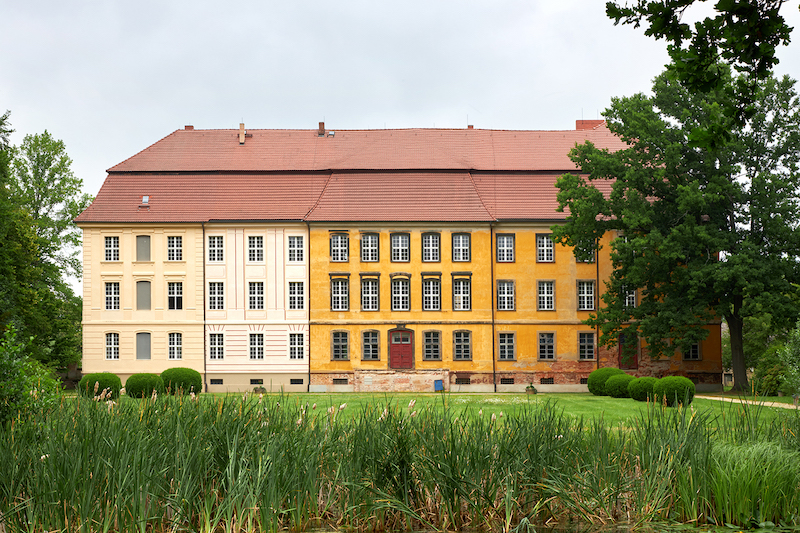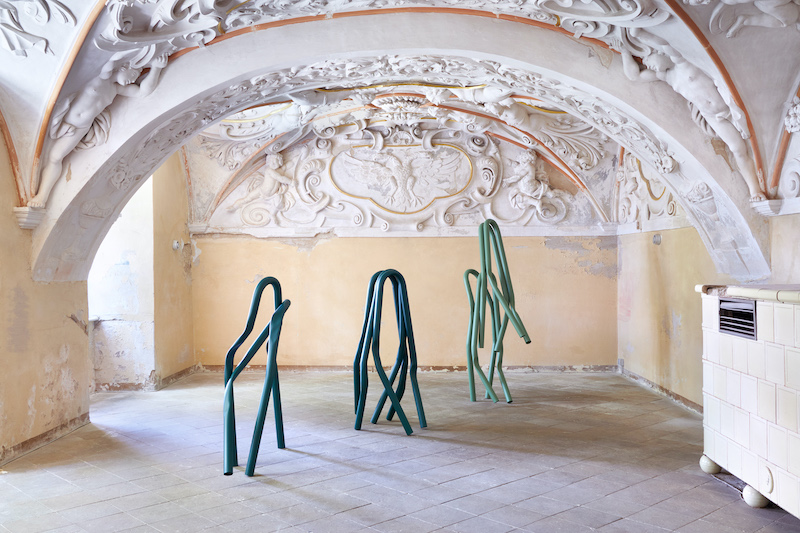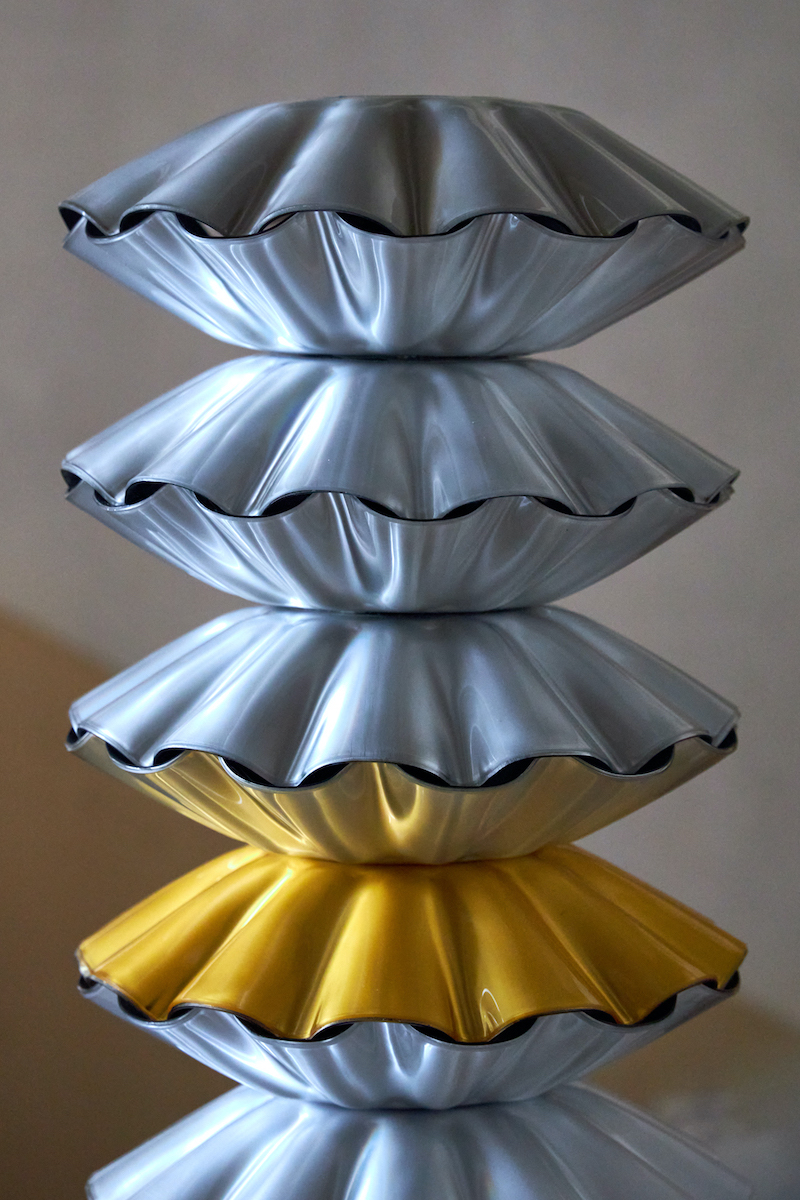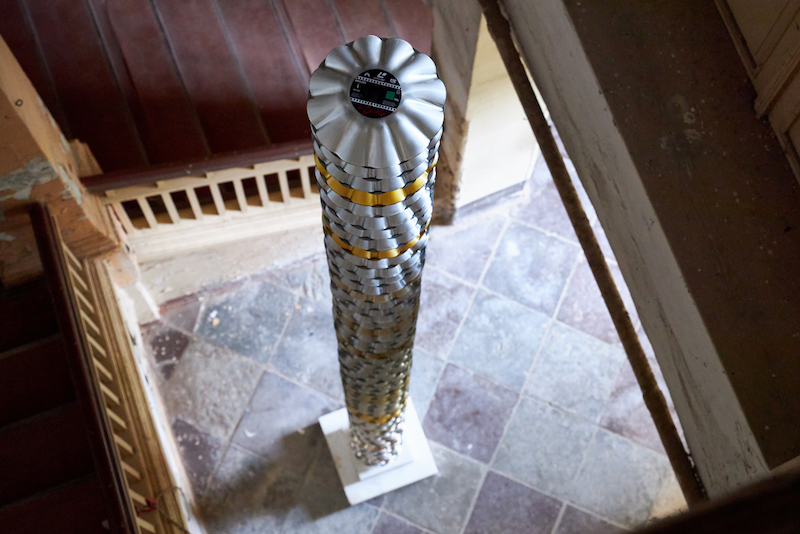by Elizabeth Schippers // July 17, 2020
At 9:45am, I step onto a bus on Museum Island, right in the heart of Berlin. A few minutes later, the landscape changes. Old Germanic buildings make way for stretches of open fields. Rows of flats disappear in the distance and are replaced by rows and rows of trees. After a little less than two hours, we arrive at Schloss Lieberose, an old castle left to decay as time inches forward. This space, so clearly affected by the passage of time, functions as the backdrop for a selection of artworks that engages with this passage in an almost contrary manner. Many of the pieces presented in this exhibition are vehemently oriented towards the present: they ask the viewer to stand still, reflect and make space for some tenderness.

Schloss Lieberose, 2020 // Photo by Jan Brockhaus
In celebration of its 25th anniversary, ROHKUNSTBAU—an art festival that originated in Brandenburg—has invited 20 artists who have participated in the festival previously to display their work in the Baroque castle, a few kilometers away from Spreewald. The festival’s yearly themes have always concentrated on cultivating a deeper understanding of cultural, social and political interconnections. This year, in light of the global COVID-19 crisis, ROHKUNSTBAU encourages the artists and audience to explore the soft spaces we find in between these challenging times. ‘Tenderness: About Common Living’ aims to free delicateness and softness from our understanding of these concepts as being kitsch or weak; instead, it invites a closeness, a togetherness, a communal living. The artists explore the soft sides of tenderness, but also take this concept to the edges of its possible meanings. Loneliness, misunderstandings and brutality are just as much a part of this discourse.

Bettina Pousstchi: 3 Objekte aus der Serie „Tree-Squeezer“, Baumschutzbügel, beschichteter Edelstahl, 2019 // © Jan Brockhaus
Over the past 25 years, ROHKUNSTBAU has held its festivals in the countryside of Berlin, connecting the bustling inner city with the calmness of quiet retreat. By stepping outside of the busy streets, suddenly, there seems more time to think, to reflect. The castle Lieberose is a sight to behold: creaky staircases lead to seemingly dead ends and a few rooms have all but collapsed. The artists have made perfect use of this unusual exhibition space. Gregor Hildebrandt’s ‘Säule, Filme für Brancusi’ (2012), a stack of golden and silver laser disks moulded into elegant encasings, spirals along one of the twirling staircases. Karin Sander was inspired by the highly decorative, Baroque ceilings when selecting her piece for the exhibition, ‘Hannes’ (2002). Other pieces, rather than striving for a perfect harmony with the castle, aim for a stark contrast.

Gregor Hildebrandt: ‘Säule, Filme für Brancusi,’ 2012, laser disk and marble, 570x35x35 cm // Photo by Jan Brockhaus

Gregor Hildebrandt: ‘Säule, Filme für Brancusi,’ 2012, laser disk and marble, 570 x 35 x 35 cm // Photo by Jan Brockhaus
With ‘Elbisbach double decker cot’ (2018), Thomas Rentmeister achieves exactly such a contrast. Against the backdrop of a space that was once a home to the elite, he has created an installation out of bed frames and children’s toys from an abandoned German refugee home. Rentmeister deepens the debate on tenderness by exploring the rough edges of this well-meaning gesture. The bed frame is covered with German games and plush toys. Not only does Rentmeister comment on the pain resulting from refugees being generally treated in a dehumanising manner, with this particular installation he also points towards the harm that arises from “well-meaning” gestures of tenderness. The displayed games showcase a lack of understanding regarding what refugees need, a lack of empathy and interest in the social and cultural background of the children that are urged to call these places their home, without having anything that binds them to it.
While a few artists provide an antithesis to the concept of tenderness (such as Michael Sailstorfer’s ‘Teppich Schöneberg’ (2016), a carpet made from police uniforms, which the audience is welcome to trample on), many of the presented works present a genuine and uncynical celebration of soft and squishy feelings. The video artist Olga Chernysheva presents the viewer with ecstasy and lightness. ‘Steamboat Dionysius’ (2004) follows a steamboat ride: it zooms in on the laughing faces, shows people dancing to the Russian folk music that comes out of the ship’s loudspeakers. The people are happy, and they are allowed to be happy. There is no cynicism, no irony, just a celebration of the love and intimacy of a group of strangers on a leisurely boat ride.
It is this genuine atmosphere of festivity that strikes me. ‘Tenderness: About Common Living’ does not shy away from having a difficult and necessary conversation about the uncomfortable and harmful sides of well-meaning gestures. Simultaneously, and—in this cultural landscape fuelled by irony and disengagement—courageously, this exhibition constitutes a fierce and unapologetic celebration of tenderness.
Exhibition Info
SCHLOSS LIEBEROSE
ROHKUNSTBAU 25: ‘Zärtlichkeit/Tenderness’
Exhibition: June 27–Sept. 20, 2020
Schlosshof 3, 15868 Lieberose/Spreewald, click here for map





















